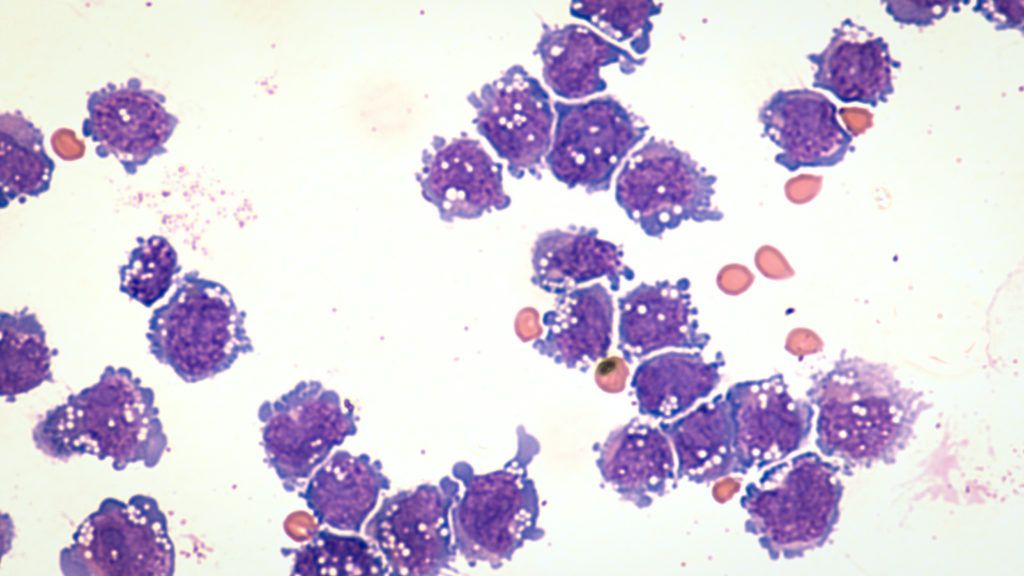“The current study is the first of its kind, wherein comprehensive transcriptome analysis using RNA-Seq was performed in Notch2 depleted B-cell lymphoma cells.”

The Trending with Impact series highlights Oncotarget publications attracting higher visibility among readers around the world online, in the news, and on social media—beyond normal readership levels. Look for future science news and articles about the latest trending publications here, and at Oncotarget.com.
—
Splenic marginal zone lymphoma (SMZL) is a rare subtype of non-Hodgkin lymphoma that comprises approximately 10% of all lymphoma cases. Marginal zone lymphomas (MZL) originate from B memory lymphocytes (B-cells) in the marginal zone of secondary lymphoid follicles within the spleen, bone marrow, and blood.
Due to the rarity of SMZL, no randomized trials have yet been reported—only retrospective studies and some prospective studies have been conducted. The irregularity of frequency and the indolent nature of this disease makes SMZL a challenge for doctors to determine a standardized care or treatment plan other than intervention by splenectomy.
Bringing with it great potential, researchers have found that a pivotal gene is mutated in SMZL: the Notch2 gene. The abnormal signaling and increased expression in Notch2 has been observed in a number of cancers, including MZL, chronic lymphocytic leukemia, breast cancer, non-small cell lung cancer, pancreatic cancer, hepatocellular carcinoma, colorectal cancer, bladder cancer, medulloblastoma, and glioblastoma.
“A wide range of Notch2 mutations have been identified with relevance to different cancers, but the role of Notch2 and its downstream pathways in development of B-cell lymphoma has not been comprehensively studied to date.”
Researchers from the School of Biotechnology and Genetic Engineering at Bharathiar University in Coimbatore, India, conducted a study of RNA sequencing analyses to reveal the differentially expressed genes and pathways as Notch2 targets in B-cell lymphoma.
Whole Transcriptome Analysis
The researchers in this study explain that transcriptome analysis and RNA sequencing (RNA-Seq) provided them the opportunity to deeply and unbiasedly screen for the molecular changes that occur in Notch2 deregulated B-cells and to identify the genes and pathways downstream from it as potential targets.
“RNA-Seq is a more sensitive technology than expression profiling analysis using arrays, due to their low sensitivity and cross-hybridization of probes and targets [34]. “
In order to deregulate, or knockdown, Notch2 expression, the researchers employed short, or small, hairpin RNAs (shRNAs). shRNAs are artificially created RNA molecules that can be used to silence target gene expression (Notch2, in this case) via RNA interference.
“To determine the efficacy of Notch2-shRNA in reducing the intracellular levels of Notch2, we treated A549 (lung cancer) and SSK-41 cells (B-cell lymphoma) with viral supernatants of two different shRNA constructs in a lentiviral vector targeting Notch2.”
“The current study is the first of its kind, wherein comprehensive transcriptome analysis using RNA-Seq was performed in Notch2 depleted B-cell lymphoma cells.”
The Study
“In the present study, whole transcriptome analysis was performed in B-cells, where Notch2 expression is knocked down using Notch2-shRNA and compared with control scramble-shRNA treated cells.”
In their first step, the researchers identified a total of 15,083 differentially expressed genes and 1067 differentially expressed transcripts in control and Notch2-shRNA treated samples. They used a condition tree, correlation matrix, and principal component analysis test to measure significant reproducibility, similarity, and distance between the treated and untreated group.
In their second step, a gene enrichment analysis was performed in the differentially expressed genes using the DAVID tool. This resulted in the identification of 208 unique gene ontology (GO) categories and pathways.
Results
“Among the 208 GO categories, 31 pathways were significantly enriched in biological processes (BP), 3 pathways were significantly enriched in cellular components (CC) and 18 pathways were significantly enriched in molecular functions (MF).”
The researchers state that the significantly enriched terms they found could help with further understanding which differentially expressed genes and differentially expressed transcripts play causative roles in the onset of B-cell lymphoma.
“The RNA-Seq and bioinformatics technology revealed notable information regarding gene expression at the transcriptome level and identified multiple significant molecular pathways in response to knockdown of Notch2.”
“The results of our gene network analysis suggest that, knockdown of Notch2 modulates multiple important cellular pathways, including immune-related pathways, apoptotic related pathway, PI3K/AKT, BCR, mTOR, VEGF, Wnt and Ca2+ signaling pathways.”
Conclusion
The authors note that the NF-kB signaling pathway is a major pathway that leads to cell survival with the ability to “cross-talk” with other survival pathways, including PI3K/AKT, in various cancers.
“Since activation of PI3K/AKT pathway is known to promote cell proliferation, cell survival, growth and angiogenesis in cancers [40], it is important to know if Notch2 propels cancer progression through activation of this pathway. “
However, the researchers mention that the exact mechanism that Notch2 regulates NF-kB activity through the activation of PI3K/AKT and inhibits apoptosis in B-cell lymphoma still need to be determined.
“Nevertheless, establishing the role of PI3K/AKT pathway in Notch2 activated cancers could be very important to consider it as an alternative treatment target in mitigating the effects of Notch2 transactivity in these cancers.”
Click here to read the full study, published in Oncotarget.
—
Oncotarget is a unique platform designed to house scientific studies in a journal format that is available for anyone to read—without a paywall making access more difficult. This means information that has the potential to benefit our societies from the inside out can be shared with friends, neighbors, colleagues and other researchers, far and wide.
For media inquiries, please contact media@impactjournals.com.
